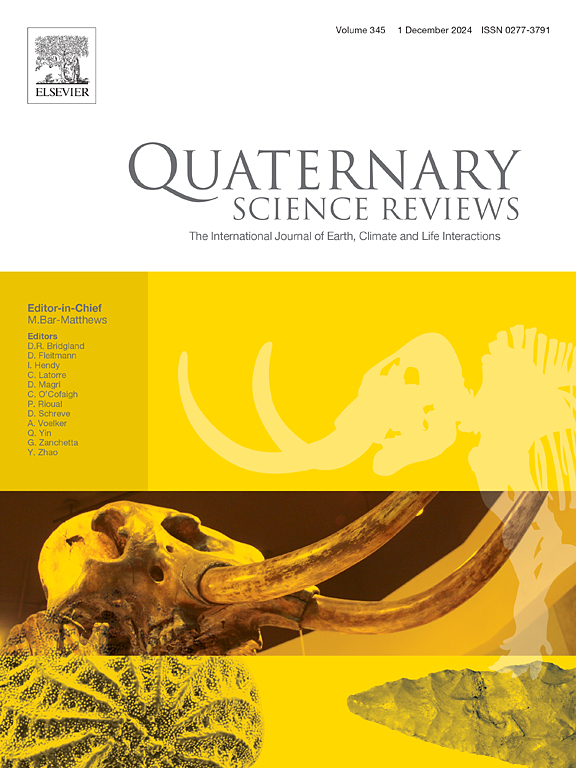A late summer temperature reconstruction based on tree-ring maximum latewood density since AD 1246 on the southeastern Tibetan Plateau
IF 3.2
1区 地球科学
Q1 GEOGRAPHY, PHYSICAL
引用次数: 0
Abstract
The Tibetan Plateau (TP) is a critical component of the Earth's climate system, exhibiting high sensitivity to climate change. However, limited spatiotemporal coverage of meteorological observations hinders a comprehensive understanding of its long-term temperature variations. This study addresses this gap by presenting an August–September minimum temperature reconstruction for the southeastern TP since AD 1246, utilizing tree-ring maximum latewood density (MXD) as a proxy. Our reconstruction explains 42.3% of the variance observed in recent instrumental data. High consistency with published MXD chronologies from nearby regions validates the reconstruction's reliability. Furthermore, the comparison of our reconstruction with summer temperature field reconstructions suggests that those integrating diverse data sources—such as tree-ring width, density, and documentary evidence—through data assimilation techniques perform better in capturing pre-instrumental temperature variability in our study area. This highlights the importance of incorporating long tree-ring density data and other varied proxies into future data assimilation models for climate reconstructions. Additionally, large tropical volcanic eruptions exert a significant cooling effect, with reconstructed temperatures dropping by 0.33 °C and 0.37 °C in the eruption year and following year, respectively. Solar activity also appears to influence regional temperatures, with warm periods (AD 1720–1805 and AD, 1830–2008) generally coinciding with high solar activity and cold episodes (AD 1268–1344, AD 1429–1480, AD 1645–1715, and AD, 1806–1830) aligning with low solar activity. However, an exceptional cool period during strong solar activity (AD 1605–1638) suggests that other factors, such as volcanic eruptions, Atlantic Multidecadal Oscillation and Pacific Decadal Oscillation variability, might also be involved.
基于1246年以来青藏高原东南部树木年轮最大迟木密度的夏末温度重建
青藏高原是地球气候系统的重要组成部分,对气候变化具有高度敏感性。然而,气象观测的时空覆盖范围有限,阻碍了对其长期温度变化的全面认识。本研究利用树木年轮最大晚期木材密度(MXD)作为替代指标,提出了自公元1246年以来青藏高原东南部8 - 9月的最低温度重建,从而解决了这一空白。我们的重建解释了最近仪器数据中观察到的42.3%的方差。与附近地区公布的MXD年表高度一致,验证了重建的可靠性。此外,我们的重建与夏季温度场重建的比较表明,那些通过数据同化技术整合不同数据源(如树木年轮宽度、密度和文献证据)的重建在捕获我们研究区域的仪器前温度变化方面表现更好。这突出了将长树木年轮密度数据和其他各种代用数据纳入未来气候重建数据同化模型的重要性。此外,大型热带火山喷发具有显著的降温作用,喷发当年和次年重建温度分别下降0.33°C和0.37°C。太阳活动似乎也影响区域温度,温暖期(公元1720-1805年和公元1830-2008年)通常与太阳活动高峰一致,而寒冷期(公元1268-1344年、公元1429-1480年、公元1645-1715年和公元1806-1830年)与太阳活动低谷一致。然而,在强烈的太阳活动期间(公元1605-1638年)的一段异常凉爽的时期表明,其他因素,如火山爆发、大西洋多年代际涛动和太平洋年代际涛动的变率也可能参与其中。
本文章由计算机程序翻译,如有差异,请以英文原文为准。
求助全文
约1分钟内获得全文
求助全文
来源期刊

Quaternary Science Reviews
地学-地球科学综合
CiteScore
7.50
自引率
15.00%
发文量
388
审稿时长
3 months
期刊介绍:
Quaternary Science Reviews caters for all aspects of Quaternary science, and includes, for example, geology, geomorphology, geography, archaeology, soil science, palaeobotany, palaeontology, palaeoclimatology and the full range of applicable dating methods. The dividing line between what constitutes the review paper and one which contains new original data is not easy to establish, so QSR also publishes papers with new data especially if these perform a review function. All the Quaternary sciences are changing rapidly and subject to re-evaluation as the pace of discovery quickens; thus the diverse but comprehensive role of Quaternary Science Reviews keeps readers abreast of the wider issues relating to new developments in the field.
 求助内容:
求助内容: 应助结果提醒方式:
应助结果提醒方式:


